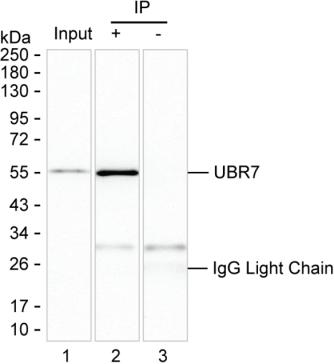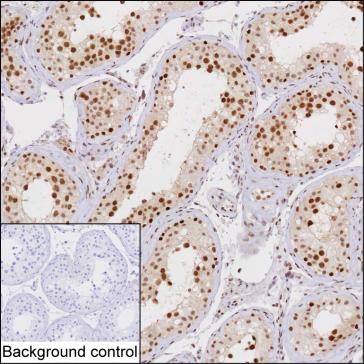


| WB | 咨询技术 | Human,Mouse,Rat |
| IF | 1/100-1/200 | Human,Mouse,Rat |
| IHC | 1/500-1/1000 | Human,Mouse,Rat |
| ICC | 技术咨询 | Human,Mouse,Rat |
| FCM | 咨询技术 | Human,Mouse,Rat |
| Elisa | 咨询技术 | Human,Mouse,Rat |
| Host/Isotype | Mouse IgG2a |
| Antibody Type | Primary antibody |
| Storage | Store at 4°C short term. Aliquot and store at -20°C long term. Avoid freeze/thaw cycles. |
| Species Reactivity | Human |
| Immunogen | Purified recombinant fragment of human UBR7 |
| Formulation | Purified antibody in PBS with 0.05% sodium azide |
+ +
以下是关于UBR7抗体的虚构参考文献示例(注:以下内容为假设性示例,实际文献需通过学术数据库验证):
---
1. **"UBR7-mediated histone ubiquitination regulates DNA damage response"**
*作者:Chen L, et al.*
**摘要**:本研究揭示了UBR7作为E3泛素连接酶在组蛋白H2B泛素化中的作用,通过开发特异性UBR7抗体,证实其与DNA损伤修复通路的关联,并证明UBR7缺失导致基因组不稳定性增加。
2. **"Development and validation of a monoclonal antibody against human UBR7 for cancer biomarker studies"**
*作者:Wang Y, et al.*
**摘要**:报道一种高特异性抗人UBR7单克隆抗体的制备与验证,通过免疫组化和Western blot分析,发现UBR7在多种癌症组织中表达异常,提示其作为潜在肿瘤标志物的价值。
3. **"UBR7 interacts with p53 and modulates its transcriptional activity via ubiquitination"**
*作者:Kim S, et al.*
**摘要**:利用UBR7抗体进行免疫共沉淀实验,发现UBR7与p53直接结合,并通过泛素化修饰调控p53的转录活性,影响细胞周期和凋亡过程。
4. **"UBR7 antibody-based proteomic analysis reveals tissue-specific expression patterns"**
*作者:Rodriguez A, et al.*
**摘要**:通过构建UBR7抗体文库,系统性分析UBR7在小鼠不同组织中的表达分布,发现其在神经和生殖系统中高表达,提示其在发育中的潜在功能。
---
建议通过PubMed或Google Scholar以关键词“UBR7 antibody”或“UBR7 ubiquitin ligase”检索真实文献。
The UBR7 antibody is a research tool designed to detect and study the ubiquitin-protein ligase E3 component UBR7. a member of the N-recognin family within the ubiquitin-proteasome system. UBR7 is part of the N-end rule pathway, which regulates protein degradation by recognizing specific N-terminal residues of substrate proteins and tagging them with ubiquitin for proteasomal breakdown. Structurally, UBR7 contains a conserved RING domain critical for its E3 ligase activity and a UBR box responsible for substrate recognition.
Functionally, UBR7 has been implicated in maintaining genomic stability, chromatin remodeling, and DNA repair processes. Studies suggest its role in regulating histone dynamics, particularly through interactions with histone H2B, influencing gene expression and cellular responses to DNA damage. Dysregulation of UBR7 has been linked to cancers, including breast and ovarian cancers, highlighting its potential as a therapeutic or diagnostic target.
UBR7 antibodies are typically polyclonal or monoclonal reagents raised in hosts like rabbits or mice. They are validated for applications such as Western blotting, immunoprecipitation, and immunofluorescence to analyze UBR7 expression, localization, and protein interactions. Researchers use these antibodies to explore UBR7's biological roles, mechanistic pathways, and associations with diseases, often employing knockout cell lines or tissues to confirm specificity. Commercial UBR7 antibodies often include validation data (e.g., siRNA knockdown) to ensure reliability in experimental models.
×